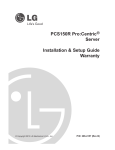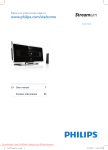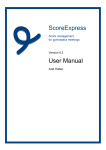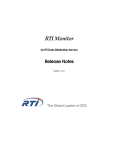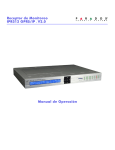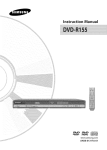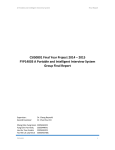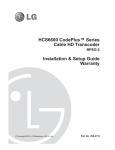Download Installation & Setup Guide
Transcript
PCS200R Pro:Centric ® Server Installation & Setup Guide Warranty © Copyright 2014 LG Electronics U.S.A., Inc. P/N: 206-4227 (Rev C) For Customer Support/Service, please call:1-888-865-3026 The latest product information and documentation is available online at: www.LGsolutions.com WARNING RISK OF ELECTRIC SHOCK DO NOT OPEN WARNING: TO REDUCE THE RISK OF ELECTRIC SHOCK DO NOT REMOVE COVER (OR BACK). NO USERSERVICEABLE PARTS INSIDE. REFER TO QUALIFIED SERVICE PERSONNEL. The lightning flash with arrowhead symbol, within an equilateral triangle, is intended to alert the user to the presence of uninsulated “dangerous voltage” within the product’s enclosure that may be of sufficient magnitude to constitute a risk of electric shock to persons. The exclamation point within an equilateral triangle is intended to alert the user to the presence of important operating and maintenance (servicing) instructions in the literature accompanying the appliance. WARNING: TO PREVENT FIRE OR SHOCK HAZARDS, DO NOT EXPOSE THIS PRODUCT TO RAIN OR MOISTURE. Apparatus shall not be exposed to dripping or splashing and no objects filled with liquids, such as vases, shall be placed on the apparatus. L’appareil ne doit pas être exposé à des égouttements d’eau ou des éclaboussures et de plus qu’aucun objet rempli de liquide tel que des vases ne doit être placé sur l’appareil. FCC NOTICE (For USA and Canada): This equipment has been tested and found to comply with the limits for a Class B digital device, pursuant to Part 15 of the FCC Rules. These limits are designed to provide reasonable protection against harmful interference in a residential installation. This equipment generates, uses and can radiate radio frequency energy and, if not installed and used in accordance with the instructions, may cause harmful interference to radio communications. However, there is no guarantee that interference will not occur in a particular installation. If this equipment does cause harmful interference to radio or television reception, which can be determined by turning the equipment off and on, the user is encouraged to try to correct the interference by one or more of the following measures: -- Reorient or relocate the receiving antenna. -- Increase the separation between the equipment and the receiver. -- Connect the equipment to an outlet on a circuit different from that to which the receiver is connected. -- Consult the dealer or an experienced radio/TV technician for help. This device complies with part 15 of the FCC Rules. Operation is subject to the following two conditions: (1) this device may not cause harmful interference and (2) this device must accept any interference received, including interference that may cause undesired operation of the device. Any changes or modifications in construction of this device which are not expressly approved by the party responsible for compliance could void the user’s authority to operate the equipment. CAUTION: Do not attempt to modify this product in any way without written authorization from LG Electronics U.S.A., Inc. Unauthorized modification could void the user’s authority to operate this product. COMPLIANCE: The responsible party for this product’s compliance is: LG Electronics U.S.A., Inc. 2000 Millbrook Drive, Lincolnshire, IL 60069, USA • Phone: 1-847-941-8000 Marketed and Distributed in the United States by LG Electronics U.S.A., Inc. 2000 Millbrook Drive, Lincolnshire, IL 60069 2 © Copyright 2014 LG Electronics U.S.A., Inc. 206-4227 IMPORTANT SAFETY INSTRUCTIONS 1. Read these instructions. 2. Keep these instructions. 3. Heed all warnings. 4. Follow all instructions. 5. Do not use this apparatus near water. 6. Clean only with dry cloth. 7. Do not block any ventilation openings. Install in accordance with the manufacturer's instructions. 8. Do not install near any heat sources, such as radiators, heat registers, stoves, or other apparatus (including amplifiers) that produce heat. 9. Do not defeat the safety purpose of the polarized or grounding-type plug. A polarized plug has two blades with one wider than the other. A grounding-type plug has two blades and a third grounding prong. The wide blade or the third prong are provided for your safety. If the provided plug does not fit into your outlet, consult an electrician for replacement of the obsolete outlet. 10.Protect the power cord from being walked on or pinched, particularly at plugs, convenience receptacles, and the point where it exits from the apparatus. 11.Only use attachments/accessories specified by the manufacturer. 12.Use only with the cart, stand, tripod, bracket, or table specified by the manufacturer or sold with the apparatus. When a cart is used, use caution when moving the cart/apparatus combination in order to avoid injury from tip-over. 13.Refer all servicing to qualified service personnel. Servicing is required when the apparatus has been damaged in any way, such as power-supply cord or plug is damaged, liquid has been spilled or objects have fallen into the apparatus, the apparatus has been exposed to rain or moisture, does not operate normally, or has been dropped. 206-4227 14.Power Sources This product should be operated only from the type of power source indicated on the marking label. If you are not sure of the type of power supply to your INSTALLATION, consult your product dealer or local power company. 15.Overloading Do not overload wall power outlets and extension cords as this can result in a risk of fire or electric shock. 16.Disconnect Device The AC mains plug is used as the disconnect device. The disconnect device must remain readily operable. 17. Object and Liquid Entry Never push objects of any kind into this product through openings as they may touch dangerous voltage points or short-out parts that could result in a fire or electric shock. Never spill liquid of any kind on the product. Do not use liquid cleaners or aerosol cleaners. 18.Outdoor Use Warning: To prevent fire or shock hazards, do not expose this product to rain or moisture. 19.Wet Location Do not use this product near water or moisture or in an area, such as a basement, that might become flooded. The apparatus shall not be exposed to dripping or splashing and no objects filled with liquids, such as vases, shall be placed on the apparatus. 20. Test Equipment In some cases, LG has supplied or recommended the use of test equipment and devices for the setup and testing of the equipment. The operation and maintenance of test equipment is described in their associated instruction manuals. Please refer to these manuals for explicit instructions regarding the safe use and handling of the equipment. (Continued on next page) 3 IMPORTANT SAFETY INSTRUCTIONS (Continued from previous page) 21. Damage Requiring Service Unplug this product from the wall power outlet and refer servicing to qualified service personnel under the following conditions: a.If the power-supply cord or plug is damaged. b.If liquid has been spilled, or objects have fallen into the product. c.If the product has been exposed to rain or water. d.If the product does not operate normally by following the operating instructions. Adjust only those controls that are covered by the operating instructions, as an improper adjustment of other controls may result in damage and will often require extensive work by a qualified technician to restore the product to its normal operation. e.If the product has been dropped or the cabinet has been damaged. f. If the product exhibits a distinct change in performance. Caution: Refer all servicing to qualified service personnel. 4 22. Servicing Caution: These servicing instructions are for use by qualified service personnel only. To reduce the risk of electrical shock, do not perform any servicing other than that described in the operating instructions unless you are qualified to do so. 23.Replacement Parts When replacement parts are required, be sure the service technician uses replacement parts specified by the manufacturer or that have the same characteristics as the original parts. Unauthorized substitutions may result in fire, electric shock, or other hazards. 24. Safety Check Upon completion of any service or repairs to this product, ask the service technician to perform safety checks to determine that the product is in proper operating condition. 25. Handling Notice Caution: Only qualified service personnel should handle and install this unit. A series of screws with lock washers are used to secure the top and bottom covers of the unit. Use caution when handling the unit as the lock washers may have rough edges. Do NOT run your fingers over the top and bottom covers of the unit. 206-4227 IMPORTANT SAFETY INSTRUCTIONS PCS200R Rack Installation (also see pages 10 to 11) To install the PCS200R in a rack: • Carefully slide the PCS200R into a standard 19-inch equipment rack. • When mounting in the rack, make sure to use the appropriate hardware. ALL FOUR MOUNTING SCREWS MUST BE USED. • This equipment is not designed to support other devices. Do NOT stack other equipment on the top of the PCS200R. • Rear cabling must be dressed and supported so that the weight of the cabling is not a strain on the PCS200R connectors. • MOUNTING OF THE EQUIPMENT IN THE RACK SHOULD BE SUCH THAT A HAZARDOUS CONDITION IS NOT ACHIEVED DUE TO UNEVEN MECHANICAL LOADING. Rack-mount Considerations A.Elevated Operating Ambient If installed in a closed or multi-unit rack assembly, the operating ambient temperature of the rack environment may be greater than room ambient. Therefore, consideration should be given to installing the equipment in an environment compatible with the maximum ambient temperature (Tma) specified by the manufacturer (see Specifications information in this document). 206-4227 B.Reduced Air Flow Installation of the equipment in a rack should be such that the amount of air flow required for safe operation of the equipment is not compromised. To ventilate the system normally and avoid overheating, leave at least 1 inch (2.5 cm) on each side (including top and bottom) of the PCS200R. Do NOT stack other equipment on the top of the PCS200R. Also, ensure that the unit’s AC power adapter is never stacked or bundled with other AC power adapters. Each adapter should have adequate ventilation and should be isolated from other heat sources. C.Circuit Overloading Consideration should be given to the connection of the equipment to the supply circuit and the effect that overloading of the circuits might have on overcurrent protection and supply wiring. D.Reliable Earthing Maintain reliable earthing of rack-mounted equipment. Particular attention should be given to supply connections other than direct connections to the branch circuit (e.g., use of power strips). E. Mains Outlet Earthing The apparatus with Class I construction must be connected to a mains socket outlet with a protective earthing connection. 5 Table of Contents Safety Warnings . . . . . . . . . . . . . . . . . . . . . . . . 2 Set the Date and Time. . . . . . . . . . . . . . . . . 26 Important Safety Instructions. . . . . . . . . . . . 3 – 5 Change the Login Password. . . . . . . . . . . . 27 Table of Contents . . . . . . . . . . . . . . . . . . . . . . . 6 Update the PCS200R Operating System via Ethernet . . . . . . . . . . . . . . . . . . . . . . . . . 28 PCS200R Product Description . . . . . . . . . . . . . 7 Setup Information . . . . . . . . . . . . . . . . . . . . . . 8 Rear and Front Panel Overviews . . . . . . . . . . . 9 Rack Installation . . . . . . . . . . . . . . . . . . . 10 – 11 Typical Rack Installation . . . . . . . . . . . . . . . 10 Rack-mount Considerations. . . . . . . . . . . . . 11 System Setup . . . . . . . . . . . . . . . . . . . . . 12 – 18 Typical Setup Flow Chart for PCS200R with ASI Output. . . . . . . . . . . . . . . . . . . . . . . 12 Typical Setup Flow Chart for PCS200R with RF Output. . . . . . . . . . . . . . . . . . . . . . . . 13 Update the PCS200R Operating System via Serial Link. . . . . . . . . . . . . . . . . . . . . . . . 28 Update the VPN Setup. . . . . . . . . . . . . . . . . 29 Shut Down the System . . . . . . . . . . . . . . . . 29 Reset the System. . . . . . . . . . . . . . . . . . . . . 30 Exit the Current Session . . . . . . . . . . . . . . . 30 Troubleshooting. . . . . . . . . . . . . . . . . . . . 31 – 32 PCS200R Setup. . . . . . . . . . . . . . . . . . . . . . 31 PCS200R Communication. . . . . . . . . . . . . . 32 Specifications . . . . . . . . . . . . . . . . . . . . . . . . . 33 Typical Setup Flow Chart for PCS200R with IP Output . . . . . . . . . . . . . . . . . . . . . . . . 14 Document Revision History / Notes . . . . . . . . 34 VPN Network Connections Overview . . . . . 14 Warranty . . . . . . . . . . . . . . . . . . . . . . Back Cover Typical System Installation. . . . . . . . . . . . . . 15 Open Source Software Notice. . . . . . . . . . . . . 35 Network and Communication Setup. . . . . . . . 19 PCS200R Configuration Options. . . . . . . 20 – 29 Log In to the PCS200R and Access the Main Menu. . . . . . . . . . . . . . . . . . . . . . . 20 View System Information. . . . . . . . . . . . . . . 21 Configure Network Settings. . . . . . . . . . . . . 21 Set the Time Zone. . . . . . . . . . . . . . . . . . . . 24 Notes • Design and specifications subject to change without prior notice. • This document provides examples of typical command line interface displays. Your displays may vary from those shown in this document. 6 206-4227 PCS200R Product Description The LG PCS200R Pro:Centric ® server is a stand-alone, remotely-controlled processor and controller for the Pro:Centric system. The server can be used to capture data from an Internet source, assemble the data as display pages, and output the pages in DTV format over ASI, RF, or IP. Features • Three output options: ASI, RF, or IP −− ASI output: The PCS200R generates one channel for GEM data only or multiplexed GEM/site data. −− RF output: Both QAM-B (6 MHz) and DVB-C (7 MHz or 8 MHz) modulations are supported. The PCS200R generates one 256-QAM or 64-QAM RF channel for GEM/site data. −− IP output: The PCS200R generates two multicast streams for GEM/site data. • Provides remote management capability over Ethernet • Small, lightweight chassis • 19-inch rack-mountable • 1U height profile to minimize rack space usage An Internet browser-based Admin Client graphical user interface (GUI), provided for system integrator (SI) partners and lodging/institution administrators, facilitates support and maintenance of the Pro:Centric system. The Admin Client enables users to remotely manage system backups, output configuration, software updates, portal/information section content, TV configuration settings, etc. 206-4227 7 Setup Information Check the following items before you begin the PCS200R installation and setup procedures. Note: Once the PCS200R hardware is installed and the initial setup is completed, output parameters are configured in the Pro:Centric server Admin Client. Along with this document, it is recommended that you have a copy of the Pro:Centric Server Admin Client User Guide readily available. ASI Output (Optional) __ If the system is using ASI output, install the modulator and upconverter that will receive the ASI output signal from the PCS200R. Refer to the manufacturer’s documentation. PCS200R __ Unpack the PCS200R Pro:Centric server unit and all accessories. PCS200R Accessories: • AC Power Cord and Adapter __ Select the location for mounting the PCS200R. Ensure adequate ventilation is available. __ Obtain the necessary attachment hardware to mount the PCS200R chassis in its targeted location. __ Plan and install the necessary cabling and network (Ethernet) and AC power access for the PCS200R. You also will need the following to connect a PC directly to the PCS200R for system setup purposes: FTDI TTL-USB cable (P/N TTL-232R-5V-AJ). 8 206-4227 Rear and Front Panel Overviews PCS200R Rear View SSD (OPTIONAL) MAXIMUM CURREN T +5V DC @ 2.0A RF-OUT 0 dBmV MODEL: PCS200R DATE: xx/xx/xx I IIIII IIIIIIII IIIIIIIIIIIIIIIIIIII IIIIIIIIIIIIIIIIIIIIII *201-1252008* FIRMWARE VER: Rx.x RF-OUT ASI-OUT Feature Port MAC ADDRESS: <Eth0> Control Port POWER 12V Service Port xx:xx:xx:xx:xx:xx <Eth1> xx:xx:xx:xx:xx:xx SSD Slot (for future SATA solid state drive functionality) RF OUT (0 dBmV) RF OUT Service Port ASI OUT FEATURE & CONTROL (Ethernet) Ports USB Port (reserved for future functionality) AC Power Cord & Adapter Disconnect Device The AC mains plug is used as the disconnect device. The disconnect device must remain readily operable. RF OUT (0 dBmV) Connector Reserved for service technician use only. When not in use, this connector must remain terminated with attached terminator accessory. PCS200R Front View PWR POWER LED Ventilation Air flow must not be obstructed. To ventilate the system normally and avoid overheating, leave at least 1 inch (2.5 cm) on each side (including top and bottom) of the PCS200R. Do NOT stack other equipment on the top of the PCS200R. Screws with Lock Washers Only qualified service personnel should handle and install the PCS200R. A series of screws with lock washers are used to secure the top and bottom covers of the PCS200R. Use caution when handling the unit as the lock washers may have rough edges. Do NOT run your fingers over the top and bottom covers of the unit. 206-4227 9 Rack Installation Typical Rack Installation 1. (Optional) As shipped, the PCS200R mounting brackets are attached flush with the front of the unit (see diagram a). If desired, the mounting brackets may be detached from the unit and reattached, for example, so that they are flush with the rear of the unit (see diagram b). If you wish to change the location/orientation of the mounting brackets, carefully remove each of the four (M4 x 10 mm) screws and attendant washers (one flat and one lock washer per screw) holding each bracket in place. Then, use the same screws and washers to reattach the mounting brackets in the desired location. 2. Carefully slide the chassis into a standard 19-inch equipment rack. 3. Use all four mounting screws to secure the chassis to the rack. (a) PWR To rack PWR To rack (b) SSD (OPTIONAL) MAXIMUM CURREN T +5V DC @ 2.0A RF-OUT 0 dBmV MODEL: PCS200R DATE: xx/xx/xx I IIIII IIIIIIII IIIIIIIIIIIIIIIIIIII IIIIIIIIIIIIIIIIIIIIII *201-1252008* FIRMWARE VER: Rx.x RF-OUT ASI-OUT Feature Port Control Port MAC ADDRESS: <Eth0> Service Port xx:xx:xx:xx:xx:xx <Eth1> xx:xx:xx:xx:xx:xx SSD (OPTIONAL) MAXIMUM CURRENT +5V DC @ 2.0A RF-OUT 0 dBmV MODEL: PCS200R DATE: xx/xx/xx I IIIII IIIIIIII IIIIIIIIIIIIIIIIIIII IIIIIIIIIIIIIIIIIIIIII *201-1252008* FIRMWARE VER: Rx.x MAC ADDRESS: <Eth0> xx:xx:xx:xx:xx:xx <Eth1> xx:xx:xx:xx:xx:xx 10 POWER 12V RF-OUT ASI-OUT Feature Port Control Port Service Port POWER 12V Use flat washer and lock washer with each M4 x 10 mm mounting bracket screw. 206-4227 Rack Installation (Cont.) Front View of Rack Cabinet 1 inch minimum PWR 1 inch minimum Rack-mount Considerations A.Elevated Operating Ambient If installed in a closed or multi-unit rack assembly, the operating ambient temperature of the rack environment may be greater than room ambient. Therefore, consideration should be given to installing the equipment in an environment compatible with the maximum ambient temperature (Tma) specified by the manufacturer (see Specifications information in this document). B.Reduced Air Flow Installation of the equipment in a rack should be such that the amount of air flow required for safe operation of the equipment is not compromised. To ventilate the system normally and avoid overheating, leave at least 1 inch (2.5 cm) on each side (including top and bottom) of the PCS200R. Do NOT stack other equipment on the top of the PCS200R unit. Also, ensure that the unit’s AC power adapter is never stacked or bundled with other AC power adapters. Each adapter should have adequate ventilation and should be isolated from other heat sources. C.Circuit Overloading Consideration should be given to the connection of the equipment to the supply circuit and the effect that overloading of the circuits might have on overcurrent protection and supply wiring. D.Reliable Earthing Maintain reliable earthing of rack-mounted equipment. Particular attention should be given to supply connections other than direct connections to the branch circuit (e.g. use of power strips). E. Mains Outlet Earthing The apparatus with Class I construction must be connected to a mains socket outlet with a protective earthing connection. 206-4227 11 System Setup Refer to the following diagrams, and complete the system installation as described on pages 15 to 18. Caution: Do NOT make system connections until instructed to do so during the system installation procedure. In some instances, configuration steps must be performed before physical connections are made. Typical Setup Flow Chart for PCS200R with ASI Output Laptop PC Service Port Connection PCS200R Network Control Port Feature Port ASI Out RF Out ASI Coaxial Cable IF In ASI In QAM Modulator IF Out RF Coaxial Cable DTV Upconverter RF Out RF Out RF Cable (0 dBmV) Combiner RF Distribution System Roo Receivm er Roo Receivm er Roo Receivm er 12 206-4227 System Setup (Cont.) Typical Setup Flow Chart for PCS200R with RF Output Laptop PC Service Port Connection PCS200R Network Control Port Feature Port ASI Out RF Out RF Cable Combiner RF Out (0 dBmV) RF Distribution System Roo Receivm er Roo Receivm er Roo Receivm er 206-4227 13 System Setup (Cont.) Typical Setup Flow Chart for PCS200R with IP Output Laptop PC Service Port Connection PCS200R Network Control Port Feature Port ASI Out 1000BaseT (default) Full Duplex RF Out CAT5E Cable RF Out IP Distribution Network Roo Receivm er (0 dBmV) Roo Receivm er Roo Receivm er VPN Network Connections Overview Pro:Centric VPN Server VPN Client Internet/ VPN PCS200R Laptop PC VPN Client 14 206-4227 System Setup (Cont.) Typical System Installation (see also Typical Setup Flow Charts and VPN Network Connections Overview diagrams) 1. If your system is using ASI output, make the following two connections; otherwise, go to step 2. • Connect a 75 ohm BNC-to-BNC coaxial cable between ASI OUT on the PCS200R and ASI IN on the modulator. • Connect an RF coaxial cable between IF OUT on the modulator and IF IN on the upconverter. Note: The BNC cable must be less than 30 feet (9.2 meters) in length. 2. To enable remote management, connect one end of a CAT5 RJ-45 Ethernet cable to the Control Port on the PCS200R rear panel, and connect the other end of the cable to the institution’s network. 3. Connect the PCS200R power supply to the POWER connector on the PCS200R rear panel. Then, plug the AC power cord into a powered AC line receptacle. When power is applied, the PWR (Power) LED on the PCS200R front panel will initially flash red and then turn green (blinking during boot-up). The boot-up process for the PCS200R may take up to two minutes. When boot-up is complete, the PWR LED on the PCS200R front panel will light continuously green. 4. Once the PWR LED is lit continuously (no longer blinking), use the FTDI TTL-232R-5V-AJ cable to connect a PC to the Service Port on the PCS200R rear panel. 5. Using HyperTerminal or an equivalent terminal emulation program on the PC, configure the serial port as follows: Bits per second/baud = 115200; Data bits = 8; Parity = None; Stop bits = 1; Flow Control = None Note: To avoid configuration errors, make sure the keyboard settings on the terminal emulator assign the backspace character to Ctrl + H (ASCII 8). Once the connection is established, you should see a login prompt. (If the login prompt is not automatically displayed, press Enter to refresh the screen.) 6. At the login as: prompt, type admin and press Enter. Then, at the password: prompt, type Password4Partners (case-sensitive) and press Enter. 7. At the Command > prompt, type info and press Enter. (You can press Enter at any PCS200R command prompt to view current menu, if desired.) Note: After the system setup is complete, it is highly recommended that you change the admin user password from its default value. See “Change the Login Password” on page 27 for further information. (Continued on next page) 206-4227 15 System Setup (Cont.) (Continued from previous page) The initial System Information display identifies PCS200R default configuration settings, including the Control Port IP address and the output configuration, for example: PCS200R Pro:Centric Server v6.9 Copyright (c) 2010 - 2014 Zenith Electronics LLC SN: Hardware ID: OS version: OS release: Ctrl MAC: Ctrl IP: Feat MAC: Feat IP: VPN IP: RF config: RF channel: Channels: Local time: 201-12301011 2 Linux 3.4.0-zenith-pcs200+ #112 SMP Mon Aug 19 10:38:49 CDT 2013 00:0C:63:40:36:14 10.166.60.92 00:0C:63:40:36:15 n/a n/a Mode 3, 256-QAM-B, RF: 6 MHz, 5.36 MSps, ASI: 38.81 Mbps 75 1 Mon Oct 20 14:42:02 EDT 2014 8. Check the Ctrl IP (Control Port IP address) field in the System Information display. By default, the PCS200R uses DHCP; thus, the DHCP server, if configured, assigns an IP address to the Control Port once the PCS200R successfully connects to the network. • If the Crtl IP field shows an IP address, the PCS200R is up and running on the network. If you wish to configure a static IP address for the Control Port and/or if you need to configure a static IP address for the Feature Port (for IP output purposes), continue with step 9. Otherwise, you can go to step 10 at this time. • If the network is configured for DHCP but the Ctrl IP field is blank, refer to “Network Setup” troubleshooting information on page 30. • If the network is not configured for DHCP, you will need to configure a static IP address for the PCS200R Control Port as described in step 9. 9. This step describes how to set a static IP address for the Control Port and/or Feature Port. Caution: Setting a static IP address for the Control Port (for remote management purposes) is optional. However, if you will be using IP output from the PCS200R, you MUST configure the Feature Port as described in step (c) below. a) At the Command > prompt, type setip and press Enter. The system will display the current network configuration, followed by the Network Configuration Menu. (Continued on next page) 16 206-4227 System Setup (Cont.) (Continued from previous page) Use the Network Configuration Menu commands indicated below and follow the system prompts to configure the port(s). See “Configure Network Settings” on pages 21 to 24 for further information. b) Use the “eth0” and “dns” commands to configure the Control Port, as necessary. c) Use the “eth1” command to configure the Feature Port, if required, for PCS200R IP output. Note that the Feature Port MUST be configured with a static IP address that is on the same network as the TV(s). Also, make sure the Feature Port speed (default: 1000 Mbps) is appropriate for your system. If necessary, at the prompt for the port speed, change the value to 100 Mbps. d) When you are finished with network configuration, type exit at the Network Configuration Menu > prompt. The system will display an overview of the new network configuration and then prompt for confirmation to save the changes: Do you want to save the new configuration? [y/n]: Type y or n and press Enter, as appropriate. Note: Review the New Network Configuration overview carefully before you confirm the configuration settings. Ensure each of the addresses was entered correctly. Note: If you changed the configuration of the port(s), you will be prompted to reset the system. You may wait to reset the system until you are directed to do so in step 11. 10.(Optional) Set the date and time on the PCS200R. By default, the PCS200R is synchronized with an NTP server and configured for the US Eastern time zone. If the PCS200R is connected to the Internet, the NTP client will periodically update the time setting on the PCS200R. You can set the time zone as required. If the PCS200R is not connected to the Internet, you also have the option to disable NTP synchronization and specify date and time data manually. Use the PCS200R “tz” and/or “time” commands (available from the Command > prompt), as necessary, to set the date and time on the PCS200R. • Use the “tz” command and follow the system prompts to change the time zone. • Use the “time” command and follow the system prompts to change the NTP configuration or manually configure the date and time parameters on the PCS200R. See “Set the Time Zone” and “Set the Date and Time” on pages 24 to 27 for further information. Note: If you changed the time zone and/or the NTP configuration, you will be prompted to reset the system. Continue with step 11, where you will be directed to initiate a reset. (Continued on next page) 206-4227 17 System Setup (Cont.) (Continued from previous page) 11.If you made any configuration changes in steps 9 and 10 that require a system reset, at the Command > prompt, type reset and press Enter. The reset process may take up to two minutes, after which the system resumes normal operation. 12.Make the appropriate connection to the RF distribution system or IP distribution network depending on the PCS200R output option to be used: • ASI output: Connect the RF output on the upconverter to the RF distribution center combiner, and balance the RF signal so that the Pro:Centric signal level at the TV(s) is between 0 to +7 dBmV. • RF output: Connect RF OUT on the PCS200R to the RF distribution center combiner, and balance the RF signal so that the Pro:Centric signal level at the TV(s) is between 0 to +7 dBmV. • IP output: Connect a CAT5E or better Ethernet cable between the Feature Port on the PCS200R rear panel and the institution’s IP distribution network. Caution (ASI/RF Output only): For proper system performance, the Pro:Centric signal level at the TV input (ANTENNA IN) must be between 0 to +7 dBmV. Note that additional equipment may be required to adjust the signal level. Caution: When not in use, the RF OUT (0 dBmV) connector must remain terminated with attached terminator accessory. 13. Configure the ASI/RF or IP output parameters in the Pro:Centric server Admin Client “RF/ IP Configuration” screen. Refer to the Pro:Centric Server Admin Client User Guide for further information. Note: By default, the server output is enabled for 256-QAM-B modulation (RF output), with the data channel set to 75. 14.Check one or more room receivers to make sure all content is properly mapped and available. 18 206-4227 Network and Communication Setup This section describes PCS200R communication options for configuration purposes. Note: Before you proceed with any additional configuration, the system should be installed and operating as described in the system installation procedure on pages 15 to 18. Also note that configuration updates periodically require that you reset the PCS200R. Make sure to reset the unit when directed to do so. There are two options for communicating with the PCS200R: • When the PCS200R is connected to an IP network, you can use an SSH client to communicate with the PCS200R via a command line interface. • To establish a direct connection to the PCS200R, connect a PC to the serial port on the PCS200R rear panel using the FTDI TTL-USB cable (P/N TTL-232R-5V-AJ). Plug the USB end of the cable into an open USB port on your PC. If necessary, install the device driver. Plug the other end of the cable into the Service Port jack on the PCS200R rear panel. Using HyperTerminal or an equivalent terminal emulation program on the PC, configure the serial port as follows: −− Bits per second/baud = 115200 −− Data bits = 8 −− Parity = None −− Stop bits = 1 −− Flow Control = None Note: To avoid configuration errors, make sure the keyboard settings on the terminal emulator assign the backspace character to Ctrl + H (ASCII 8). You will need to know the “admin” user password in order to log in to the command line interface. The default admin user password is “Password4Partners” (case-sensitive). If necessary, for example, if the password has been changed from its default value, consult the system administrator to obtain the current admin user password. Note: The default network setting for the PCS200R is DHCP, in which case the server assigns an IP address to the PCS200R. If necessary, consult the network administrator to obtain the IP address that has been assigned to the PCS200R. Note: If you want to connect the PC directly to the PCS200R Control Port using an Ethernet CAT5E cable, in order to establish communication you must first connect the PC to the PCS200R Service Port and set the PCS200R’s IP address (see “Configure Network Settings” on pages 21 to 24). The PCS200R’s IP address must be on the same subnet as the PC’s IP address. 206-4227 19 PCS200R Configuration Options Log In to the PCS200R and Access the Main Menu Note: The PCS200R must be connected to an IP network for SSH client access. For direct access to the PCS200R Service Port, use the FTDI TTL-USB cable (P/N TTL-232R-5V-AJ). See also “Network and Communication Setup” on page 19 for further information. If necessary, consult the system administrator to obtain the current “admin” user password before proceeding. The default admin user password is “Password4Partners” (case-sensitive). 1. Establish communication with the PCS200R using an SSH client or via a direct connection to the PCS200R Service Port. Once communication is established, you should see a login prompt. (If the login prompt is not automatically displayed, press Enter to refresh the screen.) 2. At the login as: prompt, type admin and press Enter. 3. At the Password: prompt, type the admin password and press Enter. 4. At the Command > prompt, either: • Press Enter to display the PCS200R Main Menu (see example below). • Type the desired command and press Enter. The following sections describe each of the configuration commands. Note: You can always press Enter at the Command > prompt to display the PCS200R Main Menu. Example: PCS200R Main Menu --------Main Menu --------info setip tz time pwd update updser vpn shut reset exit System information TCP/IP Setup Menu Timezone setup Time setup Change password Update Update via serial link VPN setup Shutdown the system System Reset End the session Command > 20 206-4227 PCS200R Configuration Options (Cont.) View System Information 1. Log in to the PCS200R as described on the previous page. 2. At the Command > prompt, type info and press Enter. The System Information display identifies important information about the PCS200R, including the unit serial number, hardware ID (firmware version), software versions, MAC addresses, and IP addresses, for example: PCS200R Pro:Centric Server v6.9 Copyright (c) 2010 - 2014 Zenith Electronics LLC SN: Hardware ID: OS version: OS release: Ctrl MAC: Ctrl IP: Feat MAC: Feat IP: VPN IP: RF config: RF channel: Channels: Local time: 201-12301011 2 Linux 3.4.0-zenith-pcs200+ #112 SMP Mon Aug 19 10:38:49 CDT 2013 00:0C:63:40:36:14 10.166.60.92 00:0C:63:40:36:15 n/a n/a Mode 3, 256-QAM-B, RF: 6 MHz, 5.36 MSps, ASI: 38.81 Mbps 75 1 Mon Oct 20 14:42:02 EDT 2014 Note: If RF output is configured for DVB-C modulation, the display will identify the RF frequency (in KHz) in place of the RF channel. It is recommended that you record this information for future reference. If you find it necessary to call customer service or engineering support, please have this information available. Configure Network Settings This option enables you to configure the network settings of the PCS200R Ethernet ports. The Control Port is used for remote communication purposes, while the Feature Port is designated for PCS200R IP output. 1. Log in to the PCS200R as described on the previous page. 2. At the Command > prompt, type setip and press Enter. The system displays an overview of the current network configuration followed by the Network Configuration Menu, for example: (Continued on next page) 206-4227 21 PCS200R Configuration Options (Cont.) (Continued from previous page) Current Network Configuration Interface eth0 Host name: Using DHCP: pcs200r YES Interface eth1 Host name: pcs200r Using DHCP: NO Host IP address: Network mask: Gateway IP address: Speed: 1000Mbps DNS servers Primary DNS: Secondary DNS: 68.94.156.1 68.94.157.1 -------------------------Network Configuration Menu -------------------------eth0 Configure Control Port IP eth1 Configure Feature Port IP dns Configure DNS exit Exit network configuration Choose item to modify > 3. Either: • Continue with step 4 for information on modifying the IP configuration of either the Control Port or the Feature Port. • Go to step 10 for information on modifying the DNS configuration. • To exit the Network Configuration Menu without modifying any settings, type exit at the Network Configuration Menu > prompt. 4. Type eth0 or eth1, as applicable, and press Enter to modify the configuration of the Control Port or the Feature Port, respectively. 5. At the Host name [pcs200r]: prompt, either press Enter to accept the default value in square brackets, or type a new host name and then press Enter. 6. (Control Port configuration only) At the Using DHCP (Y/N) [Y]: prompt, type y to use DHCP, or type n to specify the network IP addresses. Then, press Enter. (Continued on next page) 22 206-4227 PCS200R Configuration Options (Cont.) (Continued from previous page) 7. If the port is NOT using DHCP, type the information requested at each of the following prompts. Type each address in the format xxx.xxx.xxx.xxx, and press Enter after each entry. Note: If the Feature Port is to be used for IP streaming, you MUST configure the port with a static IP address that is on the same network as the TV(s). This host IP address []: Network mask []: Gateway IP address []: (Control Port configuration only) Note: If you are currently configuring the Feature Port, you will not be prompted for a gateway IP address, though you will be prompted for the port speed (see step 8). 8. (Feature Port configuration only) At the Enter Speed 100 or 1000 [1000]: prompt, either press Enter to accept the default value in square brackets, or type “100” or “1000,” as applicable, and press Enter to set the appropriate port speed (in Mbps). 9. Once you enter the gateway address (eth0) or the port speed (eth1), the system will redisplay the Network Configuration Menu. • To modify the configuration of the second Ethernet port, repeat steps 4 to 8. • To modify the DNS configuration, continue with step 10. • If no additional network configuration is required, go to step 11. 10.To change the DNS configuration, type dns and press Enter. At each of the following prompts, type the information requested. Type each address in the format xxx.xxx.xxx.xxx, and press Enter after each entry. Configuring DNS Primary DNS IP address []: Secondary DNS IP address []: Once you enter the secondary DNS IP address, the system will redisplay the Network Configuration Menu. You can select another option to modify (see previous steps) or you can exit as described below. 11.When you are finished with network configuration, type exit at the Network Configuration Menu > prompt. The system will display an overview of the new network configuration and then prompt for confirmation to save the changes, for example: New Network Configuration Interface eth0 Host name: Using DHCP: pcs200r YES (Continued on next page) 206-4227 23 PCS200R Configuration Options (Cont.) (Continued from previous page) Interface eth1 Host name: pcs200r Using DHCP: NO Host IP address: Network mask: Gateway IP address: Speed: 1000Mbps DNS servers Primary DNS: Secondary DNS: 68.94.156.1 68.94.157.1 Do you want to save the new configuration? [y/n]: 12.Type y or n and press Enter, as appropriate. If you opt NOT to save the new configuration, the system will return immediately to the Main Menu Command > prompt. Otherwise, the system will confirm the configuration updates and prompt you to reset the system: New configuration has been saved. Please restart the system. 13.If you are ready to reset the system immediately, at the Command > prompt, type reset and press Enter (see “Reset the System” on page 30 for further information). Note: If you intend to modify additional configuration settings during the current session, you may wait until all changes are complete before you reset the system. Set the Time Zone Note: See “Set the Date and Time” on page 26 for information on setting the date and time for the PCS200R. 1. Log in to the PCS200R as described on page 20. 2. At the Command > prompt, type tz and press Enter. The system displays the current time zone information for the PCS200R and prompts you to specify whether or not you wish to change the time zone. Current time zone is: America/New York Change the time zone? [y/n]: 3. Either: • Type n and press Enter to return to the Main Menu Command > prompt without changing the current time zone. • Type y and press Enter to change the time zone. Then, continue with step 4. (Continued on next page) 24 206-4227 PCS200R Configuration Options (Cont.) (Continued from previous page) 4. The system will display the following prompt for a location, followed by a list of options: Please identify a location so that time zone rules can be set correctly. Please select a continent or ocean. At the #? prompt, type the number that corresponds to the appropriate option for your location, and then press Enter. 5. The system will display the following prompt for a country, followed by a list of options: Please select a country. At the #? prompt, type the number that corresponds to the appropriate option for your country, and then press Enter. 6. The system will display the following prompt for a region, followed by a list of options: Please select one of the following time zone regions. At the #? prompt, type the number that corresponds to the appropriate option for your region, and then press Enter. After you specify the time zone region, the system displays an overview of your location selections and prompts for confirmation, for example: The following information has been given: United States Central Time Therefore TZ=’America/Chicago’ will be used. Local time is now: Mon Oct 20 16:23:10 CDT 2014. Universal Time is now: Mon Oct 20 22:23:10 UTC 2014. Is the above information OK? 1) Yes 2) No #? 7. Either: • Type 1 and press Enter if the information in the display is correct. The system will confirm the setting and then prompt you to reset the PCS200R: Time zone has been set. Please reset the board. Continue with step 8. • Type 2 and press Enter to return to the initial location prompt and reset the time zone (repeat this procedure from step 4). 8. If you are ready to reset the system immediately, at the Command > prompt, type reset and press Enter (see “Reset the System” on page 30 for further information). Note: If you intend to modify additional configuration settings during the current session, you may wait until all changes are complete before you reset the system. 206-4227 25 PCS200R Configuration Options (Cont.) Set the Date and Time By default, the PCS200R is synchronized with an NTP server and configured for the US Eastern time zone. If the PCS200R is connected to the Internet, the NTP client will periodically update the time setting on the PCS200R. If the PCS200R is not connected to the Internet, you also have the option to disable NTP synchronization and specify date and time data manually. Refer to “Set the Time Zone” above for information on setting the time zone. 1. Log in to the PCS200R as described on page 20. 2. At the Command > prompt, type time and press Enter. 3. At the Synchronize time automatically via NTP (Y/N) ? [Y]: prompt, either: • Type y and press Enter if you intend to use an NTP server for time synchronization. • Type n and press Enter to set the time manually. 4. The remaining steps depend on whether or not you opted in the previous step to synchronize time via an NTP client. Refer to the appropriate subsection below. Synchronize Time via NTP Client a) At the Enter a new NTP server IP: [time.nist.gov]: prompt, either press Enter to accept the default value in square brackets, or type the appropriate NTP server name or IP address and press Enter. b) At the Enter a new NTP update interval, in hours [12]> prompt, either press Enter to accept the default value in square brackets, or type the appropriate NTP update interval (in hours) and press Enter. The system will display confirmation and then prompt you to reset the PCS200R, for example: Time will be synchronized every 12 hours via NTP from server: xxx Please reset the board (where xxx is the NTP server name or IP address you provided above) c) If you are ready to reset the system immediately, at the Command > prompt, type reset and press Enter (see “Reset the System” on page 30 for further information). Note: If you intend to modify additional configuration settings during the current session, you may wait until all changes are complete before you reset the system. Manual Specification of Date and Time The system will display the current time (for example: Current time: 2014-10-20 18:49:56) and then initiate a series of prompts to enable you to set the time. a) At each of the following prompts, type the year, month, and day, respectively. Note that all three of these fields require numerical values. Press Enter after each entry. (Continued on next page) 26 206-4227 PCS200R Configuration Options (Cont.) (Continued from previous page) If applicable, you can also press Enter at each prompt to accept the default value in square brackets. Enter new year [2014]> Enter new month [10]> Enter new day [20]> b) At each of the following prompts, type the hour and minute, respectively. Note that the hour should be entered in 24-hour format. Press Enter after each entry. If applicable, you can also press Enter at each prompt to accept the default value in square brackets. Enter new hour (0-23) [18]> Enter new minute [49]> c) The system will display the new time and then prompt for confirmation, for example: New time: 2014-10-20 18:53:00 Apply? [y/n] Either, type y and press Enter to apply the new configuration to the system, or type n and press Enter to return to the Command > prompt without changing the time configuration. If you apply the new configuration, the system will display confirmation, for example: New time is set Change the Login Password For security purposes, it is recommended that the admin user login password be unique to the system. Note that the login password is case-sensitive. 1. Log in to the PCS200R as described on page 20. 2. At the Command > prompt, type pwd and press Enter. The system prompts for the current admin user password: Changing password for admin Old password: 3. Type the current password and press Enter. The system will then prompt you to type and retype the new password: New password: Retype password: 4. Type and then retype the new password at the prompts. Press Enter after each entry. Once you complete the Password fields successfully, the system displays confirmation: Password for admin changed by admin. 206-4227 27 PCS200R Configuration Options (Cont.) Update the PCS200R Operating System via Ethernet Caution: Do NOT initiate simultaneous menu sessions while a software update is in progress. Doing so may interfere with the active process and may corrupt the system configuration and/or cause the PCS200R to cease normal operation. This option enables you to update the PCS200R operating system via the Ethernet. The appropriate update file must be provided by LG; the system will not download an improper file. Note: See “Update the PCS200R Operating System via Serial Link” below for information on updating software via a serial link. 1. Log in to the PCS200R as described on page 20. 2. At the Command > prompt, type update and press Enter. 3. At the Enter update filename: prompt, type in the software update filename and press Enter. The system will initiate the download and confirm progress, for example: Downloading file: pcs200r_app_xxxx.upd 4. When the update is successfully completed, reset the system (see “Reset the System” on page 30 for further information). Update the PCS200R Operating System via Serial Link Caution: Do NOT initiate simultaneous menu sessions while a software update is in progress. Doing so may interfere with the active process and may corrupt the system configuration and/or cause the PCS200R to cease normal operation. This option enables you to update the PCS200R operating system via a serial link to the PCS200R. The appropriate update file must be provided by LG; the system will not transfer an improper file. Note: See “Update the PCS200R Operating System via Ethernet” above for information on updating software via the Ethernet. 1. Log in to the PCS200R as described on page 20. 2. At the Command > prompt, type updser and press Enter. 3. At the Send file using XMODEM prompt, transfer the new application/OS file using Xmodem protocol. For example, in HyperTerminal, select Transfer and then Send File.... In the Send File window, enter or select the appropriate filename in the Filename field, and select Xmodem in the Protocol field. The system will display progress messages as well as the result of the update process (which may take several minutes). 4. When the update is successfully completed, reset the system (see “Reset the System” on page 30 for further information). 28 206-4227 PCS200R Configuration Options (Cont.) Update the VPN Setup This option enables you to update the VPN client via a serial link to the PCS200R. The appropriate update file must be provided by LG; the system will not transfer an improper file. 1. Log in to the PCS200R as described on page 20. 2. At the Command > prompt, type vpn and press Enter. 3. At the Send VPN client file using Xmodem ... prompt, transfer the new VPN client file using Xmodem protocol. For example, in HyperTerminal, select Transfer and then Send File.... In the Send File window, enter or select the appropriate filename in the Filename field, and select Xmodem in the Protocol field. The system will display progress messages as well as the result of the update process (which may take several minutes). 4. When the update is successfully completed, reset the system (see “Reset the System” on the following page for further information). Shut Down the System This command allows you to shut down the system in an orderly manner. Use this command to shut down the PCS200R, for example, if you intend to physically move the unit from one location to another. It is also recommended that you run this command from the PCS200R Service Port in order to track detailed shutdown log messages. Note: Once you use this command, you must remove power from (i.e., unplug) the unit and then plug the AC power cord back into a powered AC line receptacle when you are ready to restart the server. It is not possible to restart the server remotely. 1. Log in to the PCS200R as described on page 20. 2. At the Command > prompt, type shut and press Enter. The system will prompt for confirmation: Are you sure you want to shut down the system? [y/n]: 3. Either: • Type y and press Enter to shut down the system immediately. The shutdown typically takes about a minute. When the PCS200R is in its shutdown state, the front panel LED will blink steadily green. • Type n and press Enter to return to the Main Menu without shutting down the system. 206-4227 29 PCS200R Configuration Options (Cont.) Reset the System 1. If not already logged in, log in to the PCS200R as described on page 20. 2. At the Command > prompt, type reset and press Enter. The system will prompt for confirmation: Are you sure you want to reset the system? [y/n]: 3. Either: • Type y and press Enter to initiate an immediate reset of the PCS200R. The reset process may take up to two minutes, after which the system resumes normal operation. • Type n and press Enter to return to the Main Menu without resetting the system. Exit the Current Session At the Command > prompt, type exit and press Enter to end the current session. 30 206-4227 Troubleshooting PCS200R Setup The following sections provide basic troubleshooting information for the PCS200R. Equipment Setup Review • Make sure all connectors and connections are tight and secure on all entertainment system components. • Check the PCS200R LED. Under standard operating conditions, i.e., when the PCS200R is booted and operating normally, the PWR (Power) LED on the PCS200R front panel is continuously lit green. If there is a hardware fault, the PWR LED will turn and stay red. Note: When power is first applied to the PCS200R, the PWR LED initially flashes red and then turns green (blinking during boot-up). Network Setup If the network is configured for DHCP but the PCS200R has not been assigned an IP address, i.e., the Ctrl IP field in the PCS200R System Information display is blank: 1. Check the Control Port connector on the rear panel of the PCS200R. Make sure the cable connection is tight and secure. 2. Observe the green LED on the Control Port. Once the PCS200R is connected to the network, the LED will be lit continuously. 3. Contact the network administrator to verify the network status and check that the DHCP server is working properly. 206-4227 31 Troubleshooting (Cont.) PCS200R Communication If you are unable to establish remote communication with the PCS200R, refer to the following flow chart. Cannot Communicate with PCS200R To verify the PCS200R IP address: • If DHCP is enabled, check the router for DHCP IP address assignments to determine whether the proper IP address is being used to communicate with the PCS200R. • If DHCP is not enabled, connect a PC to the PCS200R Service Port, display the System Information, and ensure the IP address shown in the Ctrl IP field is the IP address being used to communicate with the PCS200R. If necessary, update the Control Port configuration as described in this document. Check that the proper IP address for the PCS200R is being targeted. If necessary, adjust and then reattempt communication. Problem solved? Yes End No Ensure your PC’s IP address is on the same subnet as the PCS200R’s IP address. If necessary, adjust and then reattempt communication. Problem solved? Yes Note: For example, if the PCS200R is configured with IP address: 192.168.1.x and Network mask: 255.255.255.0, the PC’s IP address cannot be: 192.168.2.x. End No Contact LG. 32 206-4227 Specifications Dimensions Height: Width: Depth: Weight: 1.692 inches (42.977 mm) 19.0 inches (482.6 mm) (for EIA standard 19-inch rack mount) 8.5 inches (215.9 mm) 5.65 pounds (2.56 kgrms) rack-only weight Environmental Operating Conditions Temperature (Tma): 0° to 40° Celsius 32° to 104° Fahrenheit Humidity: 95% non-condensing Environmental Storage Conditions Temperature: -20° to 70° Celsius -4° to 158° Fahrenheit Humidity: 95% non-condensing Electrical RF Out Connectors (2) *: Frequency: RF Output Span **: RF Output Frequency Range : Active Output Level at RF Out jacks : Test Output Level: Frequency Accuracy: 75 Ohm, Type ‘F’ VHF/UHF 54-865 MHz Up to 8 Contiguous Channels (typically 48–64 MHz) 54 MHz to 865 MHz -6 dBm (+42 dBmV) Minimum, -2 dBm (+46 dBmV) Typical -48.75 dBm (0 dBmV) Typical ±5 ppm Impedance at ASI Out jack: Level at ASI Out jack: 75 Ohms 800 mv DC Input: +12V DC @ 3.25 Amps Ethernet Connector (Control Port): Ethernet Connector (Feature Port): 10/100/1000BaseT, RJ-45 100/1000BaseT Full Duplex, RJ-45 USB Port **: USB 2.0 Solid State Drive **: UL listed, FCC compliant, and/or other applicable agency-recognized/listed (Maximum current draw = +5V DC @ 2.0 Amps) Modulation Specifications Standard: ITU-T J.83 Annex B (QAM-B) Constellations: 64-QAM, 256-QAM Symbol Rate: 64-QAM 5.056941 MBaud 256-QAM 5.360537 MBaud Interleaving: Fixed I = 128, J = 1 Standard: Constellations: Symbol Rate: EN 300 429 V1.2.1 (DVB-C) 64-QAM, 256-QAM 64-QAM 6.9 MBaud 64-QAM 6.111 MBaud 256-QAM 6.9 MBaud 256-QAM 6.111 MBaud * RF OUT (0 dBmV) connector reserved for service technician use only. ** Specification for future functionality. Note: Design and specifications subject to change without prior notice. 206-4227 33 Document Revision History / Notes Document Revision History Date Description June 2014 Revision A: New document July 2014 Revision B: FCC notice update October 2014 Revision C: New system shutdown command Product documentation is available online at: www.LGsolutions.com. Notes 34 206-4227 Open Source Software Notice Product Type Pro:Centric Server Model Number/Range PCS200R Those products identified by the Product Type and Model Range above from LG Electronics, Inc. (“LGE”) contain the open source software detailed below. Please refer to the indicated open source licences for the terms and conditions of their use. Components bash, busybox, das u-boot, dev, e2fsprogs, ethtool, gawk, grep, hotplug, iptables, linux kernel, lrzsz, lzo, merge, module-init-tools, mtd-utils, net-tools, ntfs-3g, ntpclient, openvpn, pciutils, procinfo, procps, screen, skell, sysconfig, sysklogd, time, usbutils eglibc, ffmpeg, gmp, Java SwingLabs, libelf, libusb, LIVE555 Streaming Media, openRTSP, termcap License GPL 2.0 LGPL 2.0/2.1 The source code and other important information for the above may be obtained free of charge from LGE at http://opensource.lge.com. LGE will also provide open source code to you on CD-ROM for a charge covering the cost of performing such distribution (such as the cost of media, shipping and handling) upon e-mail request to [email protected]. This offer is valid for three (3) years from the date on which you purchased the product. Please be informed that LG Electronics products may contain open source software listed in the table below. Components License Apache Ant, Apache Commons EL, Apache Commons FileUpload, Apache Commons IO, Apache Commons Logging, Apache Commons Modeling, Apache Commons Net, Apache Derby, Apache HttpComponents, Apache Jakarta, Apache James, Apache Tomcat 6.0, httpd Apache License v2.0 flex, portmap, tcp-wrappers BSD License libcurl Curl License dhcp, expat MIT License openssh OpenSSH License OpenSSL OpenSSL License sudo zlib 206-4227 sudo License zlib/libpng License 35 LG PCS200R Pro:Centric Server Warranty Broadcast Products Welcome to the LG family! We believe that you will be pleased with your new PCS200R Pro:Centric Server. Please read this warranty carefully, it is a “LIMITED WARRANTY” as defined under Federal Law. This warranty gives you specific legal rights, and you may also have other rights that vary from state-to-state within the U.S.A. LG’s RESPONSIBILITY Warranty Term Parts Warranty Service Not Covered One year parts and labor from date of purchase or delivery date. New or remanufactured replacements for factory-defective parts may be used. Such replacement parts are warranted for the remaining portion of the original warranty period. Warranty service is provided at LG. Customer pays for shipping charges to LG; LG pays for return shipping charges to return PCS200R Pro:Centric Server to customer. Call 1-888-865-3026 for further information. This warranty covers manufacturing defects and does not cover installation, adjustment of customer controls, installation or repair of antenna systems, cable converters or cable company-supplied equipment; it also does not cover damage due to misuse, abuse, negligence, acts of God or other causes beyond the control of LG. Any alteration of the product after manufacture voids this warranty in its entirety. THIS WARRANTY IS IN LIEU OF ANY OTHER WARRANTY, EXPRESS OR IMPLIED, INCLUDING WITHOUT LIMITATION, ANY WARRANTY OF MERCHANTABILITY OR FITNESS FOR A PARTICULAR PURPOSE, AND LG SHALL NOT BE LIABLE FOR ANY CONSEQUENTIAL, INDIRECT, OR INCIDENTAL DAMAGES OF ANY KIND, INCLUDING LOST REVENUES OR PROFITS IN CONNECTION WITH THIS PRODUCT. SOME STATES DO NOT ALLOW LIMITATIONS ON HOW LONG AN IMPLIED WARRANTY LASTS OR THE EXCLUSION OR LIMITATION OF INCIDENTAL OR CONSEQUENTIAL DAMAGES, SO THE ABOVE LIMITATIONS OR EXCLUSIONS MAY NOT APPLY TO YOU. OWNER’S RESPONSIBILITY Effective Warranty Date Warranty begins on the date of delivery of the PCS200R Pro:Centric Server. For your convenience, keep the dealer’s dated bill of sale or delivery ticket as evidence of the purchase date. Installation Guide Read the Installation & Setup Guide carefully so that you will understand the operation of the PCS200R Pro:Centric Server and how to adjust the settings. For warranty service information, call 1-888-865-3026. Parts and service labor that are LG’s responsibility (see above) will be provided without charge. Other service is at the owner’s expense. If you have any problem in obtaining satisfactory warranty service, call 1-888-865-3026. You must provide the model number, serial number and date of purchase or date of original installation. Warranty Service For Customer Support/Service, please call: 1-888-865-3026 www.LGsolutions.com Pro:Centric is a registered trademark of LG Electronics Inc. Java is a trademark of Oracle. All other trademarks or registered trademarks are the property of their respective owners. © Copyright 2014 LG Electronics U.S.A., Inc. 206-4227 Revision C




































